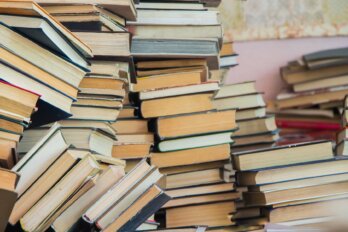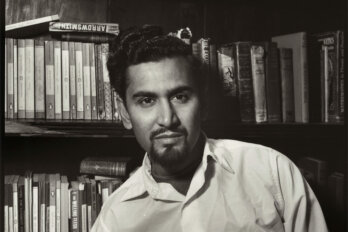Ink binds us. We are surrounded by ink, immersed in ink, a substance so common it is invisible. From cave walls to quill pens to laser printers, ink has traced the line of our culture. For millennia it was our social medium, and writing in ink used to mark our entry into the adult world. It was a rite of passage as memorable as that first drink, first drive, first kiss. But now children keyboard in kindergarten, pixels have replaced pigment, and pens will soon be as quaint as pocket watches. Even our signatures are electronic. Are we at the end of ink? This is the question I set out to explore.
We don’t really see a technology until we’re moving beyond it—the steam engine, the sailboat—but what was once utilitarian returns as a leisure activity and a luxury, like horseback riding, or taking the train, or using candles instead of electric light for dinner parties. As an English professor I’d spent my life surrounded by print, and hadn’t concerned myself much with the material book until rumours of its demise began to circulate. As for ink, it hardly figured in the equation, as long as it was readable.
A writer at Edmonton’s nonfiction literary festival remarked, “The theme of all narrative nonfiction is the Quest. Playwrights write their endings first. With nonfiction you don’t know how the book will end; you’re writing to find that out.” That may not be a universal truth, but it proved so for me. My quest began in a rare book library. I had some question about ink (now forgotten) that my sources on printing didn’t answer, so I asked the curator, “What is the book on ink? ” She said there wasn’t one. I immediately decided to write a crisp little “commodity biography,” with the required one-word-title-plus-elaboration (INK: The Fluid That Changed the World! ); I’d wrap it up in a year. Writers notoriously dream up whole books in half an hour that take them the rest of their lives to complete. My one year turned to five as the clean line of ink I’d conceived became an ever-expanding blob, drawing me further and further into the social life of ink.
The project became a pilgrimage, taking me to Budapest and Buenos Aires, the home of Lazlo Bíró, inventor of the ball-point pen. To China’s Anhui province, where there’s a factory that still makes inksticks from Ming dynasty patterns. To the border of Tibet and the world’s oldest Buddhist print shop. To Samarkand to see the first Qur’an, soaked with the blood of the caliph who was assassinated for creating it. On the road I met characters whose stories threatened to take over the book: Bíró’s daughter, who hid students during Argentina’s Dirty War; Timor, the Muslim guide who washed his pork chops down with vodka; Mr. Chi, the earnest grad student who tried to save me from a drunken lunch at a Chinese ink factory; the two Steves, one who made me grind sheep bones in Texas, the other who taught me how to flame linseed oil in the Utah desert; Aung and Cheng, the two calligraphers who mocked and revered ink; Nathan, the “Willy Wonka” of ink, who railed against the government and produces inks that melt fountain pens. Closer to home, I discovered a great-great-uncle who’d been a printer in the California Gold Rush, learned how my mother-in-law resembles Ming emperors, proved myself a failure at calligraphy, inked type, crushed gallnuts, and ground inksticks. Friends began to avoid me at dinner parties. I joined the FPN (Fountain Pen Network); I was invited to present at Nerd Nite. I saw ink everywhere.
I’m convinced that even scientific projects, no matter how arcane, from thermodynamics to string theory, are rooted in the personal, even if the writer isn’t conscious that it is so. I never knew my grandfather, Edward Thomas Bishop, and aside from a graduation photo from Osgoode Hall I have no idea what he looked like, but I inherited his library. There are no letters, no diary, but he signed all his books, and while the stiff photo holds the viewer at a distance, the ink on the page always made me feel a connection. He exists for me as a signature.
In my professional life, the experience that’s had the greatest impact was an encounter with ink. As I wrote in Riding with Rilke, I was a young Virginia Woolf scholar working in the British Museum Library, reading her correspondence:
I opened up the next manila envelope and slid out a single sheet. I found myself reading a letter I had read in print dozens of times before. Anybody who works on Woolf practically knows it by heart, it’s reprinted so often. It begins:
Dearest, I want to tell you that you have given me complete happiness. No one could have done more than you have done. Please believe that. But I know that I shall never get over this: and I am wasting your life. It is this madness…
I felt a physical shock. I was holding Virginia Woolf’s suicide note. I lost any bodily sense, felt I was spinning into a vortex, a connection that collapsed the intervening decades. This note wasn’t a record of an event—this was the event itself.
I turned the sheet over.
There Leonard had written in green ink the date: 11/5/41. This detail set off an unexpected aftershock. I had seldom thought of him, of how he had had to wait twenty-one days before the body was found. Three long weeks, answering questions from The Times, taking calls from friends. Then a group of teenagers, throwing rocks at a log in the river, found it was not a log at all and dragged what was once Virginia Woolf ashore.
The episode taught me about the impact of the material text, but what I hadn’t considered was that what I was responding to, as with my grandfather’s signature, was the ink.
I’d come to find ink itself compelling: the slurp slurp in the print shop as the thick goop warms on the rollers, becoming ready for the type before emerging on paper as deep black letters; the infinite grey shades of Chinese calligraphy; the way it flows from a well-tuned fountain pen. I talked to print-culture historian Michael Winship, who said, “There is a mystery, a magic, to ink—how does it know when to be liquid, when to be solid? ”
Travel and research only really become interesting when things fall apart, the neat itineraries go by the wayside, one thing leads to another, and you’re led off the map. The ballpoint, which I thought to dispense with in a paragraph, proved fascinating. After half a century of development it still demands the most exacting technology, yet it sells for less than a cup of coffee. It is abused and ignored, and seems to have become prominent in the popular imagination only as a weapon (Joe Pesci kills a rude thug in Casino; Rachel McAdams stabs the creepy Cillian Murphy in the windpipe in Red Eye; The Joker in the Batman movies goes for both the throat and the eye; and Matt Damon disables an assassin with a Bic in The Bourne Identity). In fact, the ballpoint found its first success as an adjunct to a weapon—it was sold to Royal Air Force bomber crews because it worked at high altitudes. With Chinese inksticks I discovered that ink could be an exquisite object, the subject of poetry, a means of entry to the emperor’s court, and a thing that engendered betrayal, murder, and the theft of concubines. The ink of the Qur’an led me to recipes for ink with anemones, the rind of pomegranates, and the gall of a turtle; to the union of the erotic and the sacred in Arabic letters; and to the Sufi mysticism of a Canadian poet. It was a haphazard line from a ballpoint on my desk to the ink cakes at the Met in New York to the illuminated Qur’ans in Istanbul. Only later did I begin to see a progression, from the utilitarian to the aesthetic to the religious engagements of ink, reflected in the sections of this book: Craft, Art, and Spirit.
The basic elements of ink are simple—pigment, liquid, and a binder to make it stick—but its applications are endless. I came away convinced that the need to write is primal, and is linked to a desire for permanence that has recently become more urgent. You too, I’m sure, have faced the Blue Screen of Death on your computer, had your documents go—where? Not up in smoke, or ripped or rotted, but into the no-where of cyberspace. Not even ash or shard to testify they had once existed. But you too have had the sensuous pleasure of a handwritten note, and maybe you too, though self-conscious about your half-printed, half-cursive scrawl, have returned to the pen, chosen your ink, discovered that it is a medium that still carries a message.
This appeared in the December 2014 issue.






